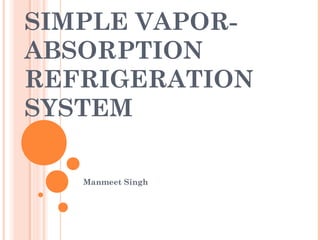The document discusses the simple vapor-absorption refrigeration system, highlighting its advantages over vapor compression systems, primarily in terms of power and refrigerant volume reduction. It details the principles of operation, including the components involved, such as the absorber, generator, and pump, as well as the thermodynamic cycles and efficiency comparisons. Additionally, it addresses practical applications, particularly in large-capacity air conditioning systems using water-lithium bromide as refrigerant and absorbent.






















































